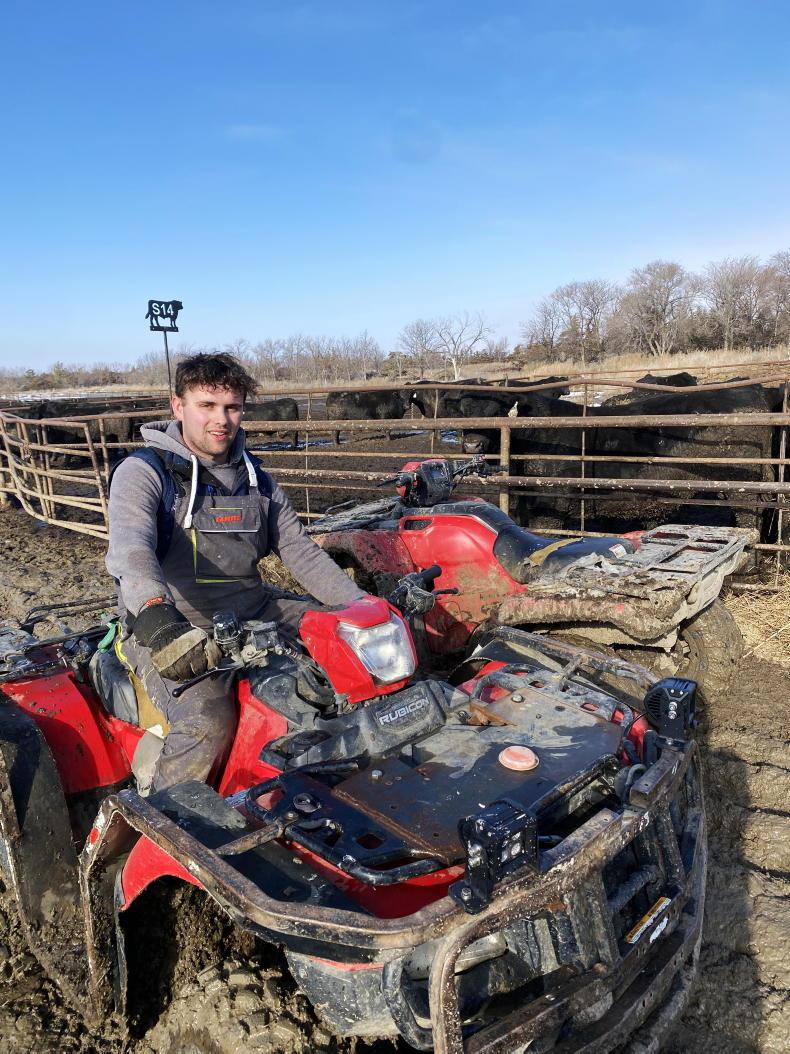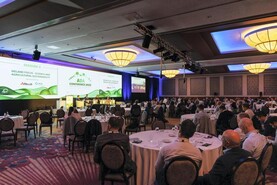Currently studying Agricultural Science in SETU in Waterford, Jack O’Connor is the second winner of this year’s ASA Travel Bursary from South East Technological University.
Jack says he chose this course because of his interest in agriculture as he grew up on the family farm – and now he wants to make a career out of it.
“I’ve completed my placement at Jorgensen Land & Cattle Partnership (JLC) in rural South Dakota,” says Jack.
“JLC is one of America’s largest suppliers of Angus bulls. Their main enterprise is the sale and leasing of Angus bulls to farmers for breeding, and they also finish some of their bulls and steers.
“Calving 1,000 cows on site, they also have a group of local contract rearers who will breed, calve and raise the farm’s cattle. At approximately one year old, they will ship them back where they will then be processed into the JLC herd and after being fertility tested, they will either go for breeding or be finished on farm and slaughtered.”
Size and scale
“One of the main differences I saw between my home farm and my placement farm was the size of the farms in America – the scale is so different to Ireland in terms of acres of land and head of cattle on a farm,” says Jack.

Jack O'Connor on PWE in South Dakota.
“JLC farms around 23,000 acres between owned and leased ground and has around 8,500 head of Angus cattle on the farm at any one time.
“Being able to work on a farm of this scale was a great experience as it is not something I would have been able to do in Ireland.
“Another difference I saw while on placement was the use of technology and computer systems to manage the cattle.
"With the large volume of animals on the farm, they use a computer system to record weight, treatments, injuries etc. Some of the cattle are also fitted with electronic tags to monitor live performance.
“The use of growth hormones in the steers was also something I hadn’t seen before in Ireland. These are inserted under the skin in the animal’s ear; the product used on the farm is a progesterone and estradiol benzoate implant.
"The difference in carcass weight could be seen at slaughter with the steers that got the implant having approximately 40-50 kg extra carcass weight when compared to steers that did not get the implant.”
Jack says that, overall, he enjoyed his placement. “I am glad I travelled to the US,” he says.
“Some of the highlights for me were learning to ride a horse while sorting cattle, driving big American machinery, and mostly seeing how the Aberdeen Angus breed has evolved to the harsh winters in South Dakota.

Jack O'Connor, on placement in South Dakota.
“I also really enjoyed looking at how JLC is managing the genetics of these Angus cattle to suit the needs of their customers and overall trying to produce the best bulls possible.
“I am hoping to use what I learned about JLC’s genetics to do my final year thesis on the JLC Angus genetics compared to an Angus animal in Ireland to see the differences in the traits of the animals as the conditions for cattle are very different in South Dakota compared to Ireland.
“What I would say to students considering a degree in agriculture would be to definitely consider it as an option. What I have seen in my course is there are so many different sectors you can branch into at the end of your degree.
“It is not strictly just agriculture, there are other aspects to the programme such as business and lab sciences that have many career options.
“Over the four years, you cover a wide range of different farming enterprises.”
Jack adds: “Some of the challenges facing young people in the sector right now is how difficult it is to start out farming, especially given how expensive all of our inputs are – the price of machinery and land.”
Read more
Editorial: for the love of hurling
IFJ Junior: Clare entrepreneur hatches an egg-citing business plan
Currently studying Agricultural Science in SETU in Waterford, Jack O’Connor is the second winner of this year’s ASA Travel Bursary from South East Technological University.
Jack says he chose this course because of his interest in agriculture as he grew up on the family farm – and now he wants to make a career out of it.
“I’ve completed my placement at Jorgensen Land & Cattle Partnership (JLC) in rural South Dakota,” says Jack.
“JLC is one of America’s largest suppliers of Angus bulls. Their main enterprise is the sale and leasing of Angus bulls to farmers for breeding, and they also finish some of their bulls and steers.
“Calving 1,000 cows on site, they also have a group of local contract rearers who will breed, calve and raise the farm’s cattle. At approximately one year old, they will ship them back where they will then be processed into the JLC herd and after being fertility tested, they will either go for breeding or be finished on farm and slaughtered.”
Size and scale
“One of the main differences I saw between my home farm and my placement farm was the size of the farms in America – the scale is so different to Ireland in terms of acres of land and head of cattle on a farm,” says Jack.

Jack O'Connor on PWE in South Dakota.
“JLC farms around 23,000 acres between owned and leased ground and has around 8,500 head of Angus cattle on the farm at any one time.
“Being able to work on a farm of this scale was a great experience as it is not something I would have been able to do in Ireland.
“Another difference I saw while on placement was the use of technology and computer systems to manage the cattle.
"With the large volume of animals on the farm, they use a computer system to record weight, treatments, injuries etc. Some of the cattle are also fitted with electronic tags to monitor live performance.
“The use of growth hormones in the steers was also something I hadn’t seen before in Ireland. These are inserted under the skin in the animal’s ear; the product used on the farm is a progesterone and estradiol benzoate implant.
"The difference in carcass weight could be seen at slaughter with the steers that got the implant having approximately 40-50 kg extra carcass weight when compared to steers that did not get the implant.”
Jack says that, overall, he enjoyed his placement. “I am glad I travelled to the US,” he says.
“Some of the highlights for me were learning to ride a horse while sorting cattle, driving big American machinery, and mostly seeing how the Aberdeen Angus breed has evolved to the harsh winters in South Dakota.

Jack O'Connor, on placement in South Dakota.
“I also really enjoyed looking at how JLC is managing the genetics of these Angus cattle to suit the needs of their customers and overall trying to produce the best bulls possible.
“I am hoping to use what I learned about JLC’s genetics to do my final year thesis on the JLC Angus genetics compared to an Angus animal in Ireland to see the differences in the traits of the animals as the conditions for cattle are very different in South Dakota compared to Ireland.
“What I would say to students considering a degree in agriculture would be to definitely consider it as an option. What I have seen in my course is there are so many different sectors you can branch into at the end of your degree.
“It is not strictly just agriculture, there are other aspects to the programme such as business and lab sciences that have many career options.
“Over the four years, you cover a wide range of different farming enterprises.”
Jack adds: “Some of the challenges facing young people in the sector right now is how difficult it is to start out farming, especially given how expensive all of our inputs are – the price of machinery and land.”
Read more
Editorial: for the love of hurling
IFJ Junior: Clare entrepreneur hatches an egg-citing business plan








 This is a subscriber-only article
This is a subscriber-only article









SHARING OPTIONS: